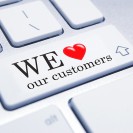
Outstanding Customer Experiences – A Competitive Advantage
In the context of highly competitive markets there comes the need to focus on customer satisfaction, retention and recovery. To your organization this means creating an environment that supports members in consistently providing high-quality service to their customers, meeting and exceeding their needs.
Key messages
In today’s very competitive business environment it is more and more difficult to maintain the loyalty of existing customers only by satisfying their needs. An organization that aims to meet its customer needs will be replaced by another that succeeds in exceeding them. In addition to quality products and services we all expect from our suppliers interactions and behaviors that will please us and even delight us.
Success in this context belongs to companies that are able to create outstanding experiences for their customers, in a consistent manner.
Attitudes and behaviors towards customers
This training program is about attitudes, behaviors and interactions that support an organization’s approach towards high quality services and relationships with its customers and thus, the delivery of positive buying and collaboration experiences.
The participants learn through their own involvement and contribution how certain thinking styles, assumptions and values influence the performance of a person that works directly with customers and, by extrapolation, the performance of the organization.
The topics covered by the program are:
- Key factors in customer service;
- What is service? – a powerful definition;
- Individual thinking styles and values – the Human Synergistics model of personal effectiveness;
- Customer service excellence – an example of a successful company;
- Outstanding customer experiences – high impact actions;
- Personal development – learning, application, improvement of knowledge and skills.
Thinking styles and customer interactions
A key activity undertaken at the beginning of the program is represented by a self-evaluation of the thinking styles, values and attitudes that influence the way participants approach work and relationships. The results of this assessment are linked with all the other subjects and activities in the program.
The development effort doesn’t stop at the end of the training session. The participants are guided and encouraged to prepare a personal development plan and to apply it in the medium and long term. This activity is supported by a follow up session organized a number of weeks after the main session.
Who should participate
The program is recommended to all individuals that want to develop their customer service skills:
- members of sales, marketing and logistics teams;
- members of customer care/customer support departments;
- members of technical assistance and service teams;
- all employees of a service company.
Objectives
The objectives of this program are:
- increase awareness about assumptions, attitudes and behaviors that support the delivery of high-quality services;
- improve abilities to approach customer situations in a constructive manner;
- individual development through learning, experimentation and interaction.
Benefits
Some of the benefits of the program are:
- improve the individual performance of the people involved in serving customers;
- improve their relationships with customers and co-workers;
- achieve a superior internal alignment as regards customer service attitudes and activities;
- improve the overall business performance of the organization through the delivery of outstanding customer experiences.
Administration
The program takes form of 1 training session of 2 days when it is delivered face-to-face or 4 training sessions of 4 hours each when it is delivered online. A 2-3 hours follow up session organized 4-6 weeks after the program facilitates the preparation of a personal development plan and the consolidation and the application of the new knowledge.
The program includes 8 work segments that constitute a dynamic and attractive balance between:
- 2 individual activities (assessment, development);
- 2 group activities (seminar, conclusions);
- 4 team activities (simulations, exercises).
The learning methods used in the program emphasise teamwork and stimulate the interaction between participants and their contribution to the final result.
